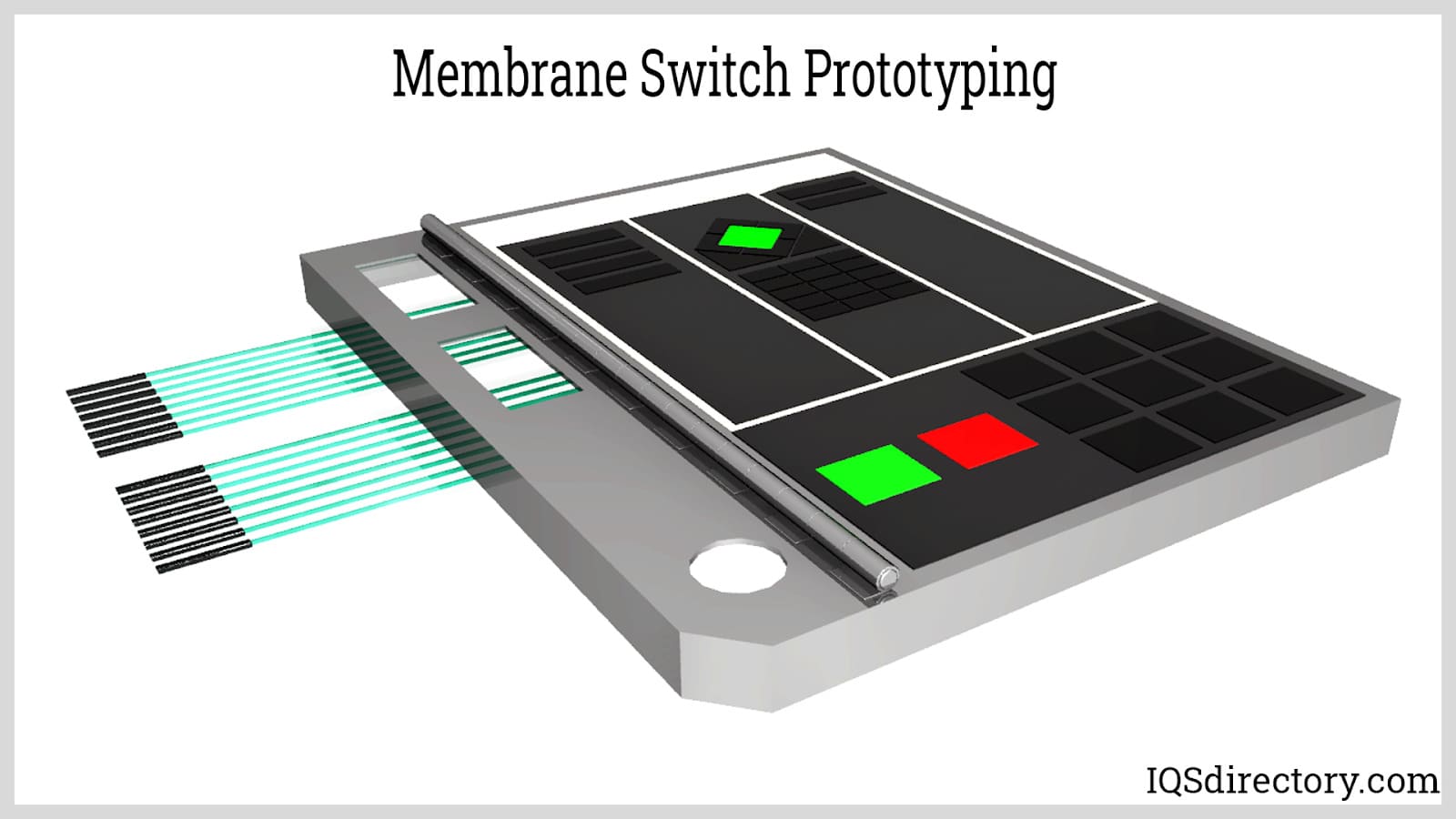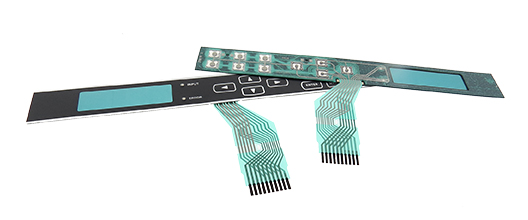All About Membrane layer Switch Over: A Comprehensive Guide for Beginners
Membrane layer switches are vital components in modern-day electronics, supplying a special interface for individual interaction - membrane switch. Their layered building and construction, including overlays and conductive traces, supplies performance and toughness. Unlike conventional mechanical buttons, membrane layer switches provide a sleek layout and personalized alternatives. Understanding their vital features and advantages can change product design. However, the ins and outs of their application and design considerations require further exploration
What Is a Membrane Switch?
A membrane layer button is a sort of electric button that consists of an adaptable membrane layered over a printed motherboard. This layout permits for a compact and smooth interface, often made use of in various digital gadgets. Membrane layer buttons are frequently located in consumer appliances, medical tools, and industrial equipment due to their resilience and resistance to ecological factors.The construction usually consists of numerous layers, such as graphic overlays and sticky backing, which supply responsive comments and secure the wiring beneath. The procedure of a membrane button is launched when stress is put on the surface area, completing an electric circuit.These switches are valued for their convenience, making it possible for custom styles and published graphics that satisfy details interface. Their low-profile nature reduces room demands, making them excellent for applications where traditional switches might not fit. Generally, membrane layer buttons use a aesthetic and practical option for contemporary electronic gadgets.
Secret Parts of Membrane Changes
Membrane switches over consist of a number of vital elements that contribute to their capability and performance. The leading layer, referred to as the overlay, offers the individual interface and is often published with graphics or signs. Under the overlay exists a spacer layer, which separates the conductive aspects and prevents inadvertent activation. The next essential component is the visuals layer, which improves appearances and guarantees the resilience of the design.Conductive traces, commonly made from products like silver or carbon, are published on the circuit layer. When stress is put on the overlay, these traces enter into get in touch with, finishing the circuit. Additionally, a support layer offers structural support and can be made from materials such as polyester or polycarbonate. With each other, these elements develop a trusted, easy to use interface appropriate for various applications, from family appliances to commercial equipment. Understanding these components is crucial for any individual thinking about membrane button innovation.
How Membrane Layer Switches Over Work
Recognizing just how membrane changes feature is vital for appreciating their widespread use in numerous tools. A membrane layer button runs with a collection of layers, consisting of a graphic overlay, spacer, and a circuit layer. When stress is put on the overlay, it presses the spacer layer, allowing the circuit layer to make call and finish an electric circuit. This activity sends out a signal to the device, triggering a feedback, such as activating a light or triggering a function.Membrane changes can be developed with various functions, including responsive feedback, backlighting, and customized graphics, boosting individual communication. Their building permits a closed design, securing the inner components from dust, wetness, and pollutants. This toughness makes them appropriate for varied applications, from consumer electronic devices to commercial tools. In general, the simpleness and effectiveness of membrane switches contribute to their popularity in modern-day innovation.
Benefits of Membrane Switches Over Over Mechanical Buttons
While mechanical buttons have long been a staple in lots of devices, membrane layer changes deal distinctive advantages that make them progressively appealing. One substantial benefit is their slim account, enabling even more portable styles and better adaptability in item development. In addition, membrane layer switches attribute an uniform surface area, which improves aesthetic appeal and streamlines cleaning, making them appropriate for settings where health is critical.Another advantage is their resistance to dirt and moisture. Unlike mechanical switches, which can be compromised by environmental aspects, membrane layer switches provide a sealed user interface that secures versus contaminants - membrane switch. Additionally, membrane switches usually have a longer life expectancy because of fewer relocating parts, causing improved durability and reliability.Cost-effectiveness is likewise a notable advantage, as membrane switches can be generated wholesale with reduced production costs. These factors combine to place membrane buttons as a practical choice to standard mechanical alternatives in different applications
Typical Applications of Membrane Changes
Membrane buttons are extensively used in various industries, specifically in consumer electronics and commercial control panels. In consumer devices, they supply a streamlined, user-friendly interface, while in industrial setups, they boost longevity and performance. Comprehending these applications highlights the versatility and functionality of membrane layer switches in modern-day innovation.
Consumer Electronic Devices Tools
As consumer electronic devices remain to develop, membrane buttons have ended up being a prominent choice for a selection of devices because of their flexibility and sleek design. These buttons are generally found in smartphones, tablets, and remote controls, where area is limited and aesthetics matter. Their low account and personalized layouts permit suppliers to develop easy to use interfaces that enhance the total individual experience. Furthermore, membrane layer switches are typically made use of in devices such as microwaves and coffee machine, offering user-friendly control choices while standing up to dampness and dust. The resilience and integrity of membrane changes make them ideal for everyday consumer products, making certain durability and constant efficiency. Overall, their combination in consumer electronic devices reflects a mix of performance and modern design.
Industrial Control Panels
The applications of membrane changes extend beyond consumer electronic devices, discovering substantial usage in commercial control board. These buttons are favored for their longevity and resistance to extreme atmospheres, making them perfect for making and process control setups. They provide a dependable user interface for drivers to regulate machinery, screen processes, and adjust setups. Membrane layer switches can be tailored to match particular functional needs, including functions like backlighting and tactile comments, enhancing user experience. Their low-profile design enables combination right into different devices, while their capacity to withstand spills, dust, and extreme temperature levels warranties long life. On the whole, membrane buttons contribute to efficient and safe operation in industrial applications, demonstrating their adaptability and performance sought after environments.
Factors To Consider for Creating Membrane Layer Changes
When creating membrane switches, view website selecting the right materials is important to guarantee sturdiness and performance. Furthermore, understanding layer setup methods can considerably impact the button's performance and individual experience. These considerations play a crucial duty in producing efficient and trustworthy membrane layer switch styles.
Product Choice Relevance
Product choice plays a crucial role in the style and functionality of membrane layer switches. The picked materials straight affect the switch's toughness, tactile response, and general visual. Trick considerations include the substrate, which need to supply architectural integrity while enabling flexibility, and the graphic overlay, which requires to be immune to use and ecological variables. Conductive products must ensure trustworthy electric efficiency, while adhesives need to supply solid bonding without jeopardizing the switch's operation. Furthermore, compatibility with producing processes and end-user environments is essential; materials have to withstand differing temperatures, moisture levels, and chemical exposure. Ultimately, suitable material option not just boosts the membrane layer switch's efficiency however additionally adds to its durability and individual contentment, making it an essential aspect of the layout procedure.

Layer Setup Methods

Regularly Asked Concerns
The Length Of Time Do Membrane Layer Switches Over Normally Last?
Membrane buttons usually have a life-span of 1 to 5 million cycles, relying on usage and ecological problems. Factors such as design top quality and operating frequency greatly influence their longevity and total efficiency long life.

Can Membrane Changes Be Customized for Particular Designs?
Membrane layer buttons can without a doubt be tailored to fit particular styles, permitting diverse forms, colors, and functionalities. This versatility makes it possible for suppliers to customize these switches to fulfill special aesthetic and operational requirements properly.
What Materials Are Used in Membrane Layer Switch Construction?
Membrane layer switches are commonly constructed making use of materials such as polyester, polycarbonate, and sticky layers. These products offer versatility, resistance, and sturdiness to ecological variables, making certain the buttons operate efficiently in numerous applications and conditions.
Are Membrane Switches Water-proof or Resistant to Dampness?
Membrane layer switches can be made to be moisture-resistant, utilizing specialized products and layers. Their water resistant capacities depend on building and construction quality and particular applications, making it necessary to evaluate demands for excellent performance in numerous atmospheres.
Exactly How Are Membrane Layer Changes Repaired if Damaged?
Repairing damaged membrane layer switches over typically involves replacing the influenced layer or circuit. Specialists may also use conductive adhesive or make use of specialized repair work kits, making certain capability is recovered without total substitute of the whole switch setting up. Unlike traditional mechanical buttons, membrane buttons present a sleek style and personalized alternatives. A membrane layer button is a type of electric switch that is composed of a flexible membrane layered over a published circuit board. The procedure of a membrane switch is initiated when stress is applied to the surface area, completing an electrical circuit.These buttons are valued important site for their adaptability, enabling custom-made layouts and printed graphics that provide to details individual interfaces. While mechanical switches have actually long been a staple in many gadgets, membrane changes offer distinctive benefits that make them significantly appealing. Membrane layer switches normally have a longer life-span due to less moving parts, next page resulting in improved resilience and reliability.Cost-effectiveness is additionally a remarkable benefit, as membrane layer switches can be created in bulk with reduced production prices.
Comments on “What engineers need to know about membrane switch for medical systems”